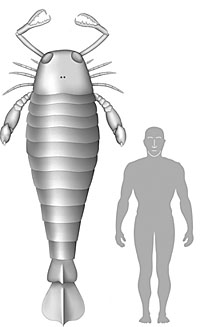 | This illustration shows the size of the giant sea scorpion relative to a human man. The eight-foot-long creature lived between 460 and 244 million years ago. The fossil claw is a foot-and-a-half long. |
The gigantic fossil claw of a 390 million-year-old sea scorpion recently found
in Germany shows that ancient arthropods — spiders, insects, crabs and
the like — were surprisingly larger than their modern-day counterparts. — By Janet Emanuel
T H I S
SCHOOL OF MEDICINE NEWS
Fossil from giant sea scorpion found
“Imagine an eight-foot-long scorpion,” says O. Erik Tetlie, postdoctoral
associate in Yale’s Department of Geology and Geophysics, and an author
of the report online in Royal Society Biology Letters. “The claw itself
is a foot-and-a-half long — indicating that this ancient arthropod is much
larger than previous estimates — and certainly the largest seen to date.”
Colleague and co-author Markus Poschmann discovered the fossil claw from this
ancient sea scorpion, Jaekelopterus rhenaniae, in a quarry near Prüm in
Germany. The sea scorpion, which lived between 460 and 255 million years ago,
is the latest addition to a group of extinct creatures that scientists have
known about for some time that includes the largest arthropods ever found,
based on both body fossils and trace fossils. According to the authors, it
is believed that these extinct aquatic creatures are the ancestors of modern
scorpions and spiders.
Tetlie notes that geologists are debating the reasons for the evolution
of these giant arthropods, “While some believe they evolved with the
higher levels of atmospheric oxygen that were present in the past, some say
they evolved in a parallel ‘arms race’ with early armoured fish
that were their likely prey,” he says.
Lead author Simon Braddy from the Department of Earth Sciences at the University
of Bristol, United Kingdom, says: “This is an amazing discovery. We have
known for some time that the fossil record yields monster millipedes, super-sized
scorpions, colossal cockroaches and jumbo dragonflies, but we never realized,
until now, just how big some of these ancient creepy-crawlies were.”
The Norwegian Research Council funded Tetlie’s work on the evolutionary
relationships of the ancient organisms.
 W E E K ' S
W E E K ' S S T O R I E S
S T O R I E S![]()
 Restoration of iconic Rudolph building is key step in . . . Arts Complex
Restoration of iconic Rudolph building is key step in . . . Arts Complex![]()
![]()
 Three faculty win nation’s highest award for beginning researchers
Three faculty win nation’s highest award for beginning researchers![]()
![]()
 Bulldogs, Crimsons both bringing undefeated Ivy records . . .
Bulldogs, Crimsons both bringing undefeated Ivy records . . .![]()
![]()
 A grateful nation
A grateful nation![]()
![]()
 New technology allows view of protein interactions in living cells
New technology allows view of protein interactions in living cells![]()
![]()
 Monkeys and children share adults’ tendency to rationalize choices
Monkeys and children share adults’ tendency to rationalize choices![]()
![]()
 Noted composer Benjamin Lees donates his archive to Yale library
Noted composer Benjamin Lees donates his archive to Yale library![]()
![]()
 Museum joins with area public schools to promote ‘visual literacy’
Museum joins with area public schools to promote ‘visual literacy’![]()
![]()
 A conversation in China leads to successful research collaboration
A conversation in China leads to successful research collaboration![]()
![]()
 Junior faculty earn second terms in endowed posts
Junior faculty earn second terms in endowed posts![]()
 Study: Simple measures could prevent spread of . . . tuberculosis
Study: Simple measures could prevent spread of . . . tuberculosis![]()
 Erol Fikrig, specialist in vector-borne diseases . . .
Erol Fikrig, specialist in vector-borne diseases . . .![]()
 Physical and emotion stress linked to aortic rupture
Physical and emotion stress linked to aortic rupture![]()
 Groundbreaking scientist joins Yale Stem Cell Center
Groundbreaking scientist joins Yale Stem Cell Center![]()
 Team develops blood test for deadly aneurysm disease
Team develops blood test for deadly aneurysm disease![]()
 Workshop will showcase new Positron Emission Tomography Center
Workshop will showcase new Positron Emission Tomography Center![]()
![]()
 Four decades of readers in Yale libraries are featured in exhibition
Four decades of readers in Yale libraries are featured in exhibition![]()
![]()
 Video installations by Ori Gersht on view at British Art Center
Video installations by Ori Gersht on view at British Art Center![]()
![]()
 Reception will celebrate United Way donors as campaign continues
Reception will celebrate United Way donors as campaign continues![]()
![]()
 Yale Books in Briefs
Yale Books in Briefs![]()
![]()
 Benefit event to feature noted neurosurgeon
Benefit event to feature noted neurosurgeon![]()
![]()
 Workshop to feature Ohio State law professor
Workshop to feature Ohio State law professor ![]()
![]()
 Reminder: Open enrollment period ends Nov. 18
Reminder: Open enrollment period ends Nov. 18![]()
![]()
 Campus Notes
Campus Notes![]()
Bulletin Home |
| Visiting on Campus
Visiting on Campus |
| Calendar of Events
Calendar of Events |
| In the News
In the News![]()
Bulletin Board |
| Classified Ads
Classified Ads |
| Search Archives
Search Archives |
| Deadlines
Deadlines![]()
Bulletin Staff |
| Public Affairs
Public Affairs |
| News Releases
News Releases |
| E-Mail Us
E-Mail Us |
| Yale Home
Yale Home